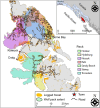Vegetation influences wolf fine-scale habitat selection and movement rate in a logged coastal rainforest
- PMID: 40014113
- PMCID: PMC11868358
- DOI: 10.1007/s00442-025-05677-5
Vegetation influences wolf fine-scale habitat selection and movement rate in a logged coastal rainforest
Abstract
Vegetation and its modification by humans can shape wildlife habitat selection and movement. A better understanding of how wolves select and move through natural and human modified vegetative cover can be used to implement forest management that considers impacts on wolves and their prey. We analyzed fine-scale wolf habitat selection and movement in a coastal temperate rainforest (Prince of Wales Island, Alaska, USA) in relation to: (1) young (≤ 30 years) and old (> 30 years) logged areas, (2) continuous measures of vegetative cover (as estimated via LiDAR), and (3) distance to roads, using integrated step-selection analysis (iSSA). Wolves selected areas with less forest canopy and understory cover at the population level, although they switched to selecting understory when within logged forest stands. The continuous canopy and understory measures vary at a fine spatial scale and thus appear to better explain fine-scale wolf selection and movement than categorical landcover classes representing the age of logged stands. Wolf selection of young (≤ 30 years) and old (> 30 years) successional logged areas, and areas near roads, was mixed across individuals. All individual wolves avoided canopy cover, but varied in their selection of logged stands, understory, and roads. Similarly, there was variability in movement rate response across individual wolves, although at the population level wolves moved faster through old (> 30 years) logged areas and through areas with less understory vegetation. Open vegetation including that present recently after logging is selected by wolves, and facilitates wolf movement, but this effect may be ephemeral as vegetation undergoes succession.
Keywords: Canis lupus; Habitat selection; Rainforest; Roads; iSSA.
© 2025. The Author(s).
Conflict of interest statement
Declarations. Conflicts of interest: The authors declare that they have no conflict of interest. Ethical approval: This study followed the guidelines established by the ADF&G Animal Care and Use Committee (ACUC #2012–028 and #2014–15) and the American Society of Mammalogists.
Figures






References
-
- Alaback PB (1984) Plant succession following logging in the Sitka spruce-western hemlock forests of Southeast Alaska: implications for management. USDA Forest Service Gen. Tech. Report PNW-GTR-173. 26
-
- Albert DM, Schoen JW (2013) Use of historical logging patterns to identify disproportionately logged ecosystems within temperate rainforests of Southeastern Alaska. Conserv Biol 27:774–784. 10.1111/cobi.12109 - PubMed
-
- Avgar T, Potts R, Lewis MA, Boyce MS (2016) Integrated step selection analysis: bridging the gap between resource selection and animal movement. Methods Ecol Evol 7:619–630. 10.1111/2041-210X.12528
-
- Banner A, Lepage P (2008) Long-term recovery of vegetation communities after harvesting in the coastal temperate rainforests of norther British Columbia. Can J for Res 38:3098–3111. 10.1139/X08-145
MeSH terms
Grants and funding
LinkOut - more resources
Full Text Sources

